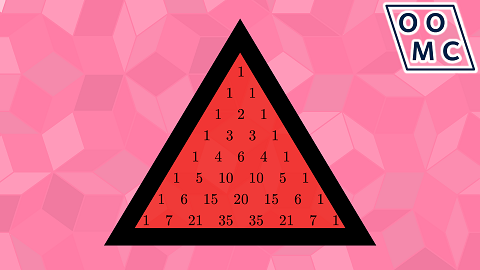Season 9 Episode 11

By special request, we're covering some number theory on the Oxford Online Maths Club, looking for primes and triangles within Pascal's triangle.
Further Reading
Binomial Coefficients
The numbers in Pascal’s triangle are called the binomial coefficients. That’s because they’re the coefficients that you get when you expand \((1+x)^n\) for some natural number \(n\), and that‘s called a binomial expansion because there are two things inside the bracket. We didn’t have time in the episode to talk about the link between binomial expansion and choosing.
Let’s imagine that we’re going to actually multiply out \(n\) brackets, each of which is \((1+x)\). Gosh, that would be a lot of work. I'd start from the right, I think, making a huge expression as I go, which I need to multiply by \((1+x)\) again and again and again. I might save any simplification for the end, only collecting together like terms when I’ve multiplied out all \(n\) terms (this is not a very good idea, but bear with me).
If that’s my plan, I’ll have \(1\) times each term and \(x\) times each term. To start off with I’ll have \(1+x\), then \(1\times 1 + 1\times x+x\times 1 + x\times x\). I'm really not simplifying as I go! Next I'll have $$ 1\times 1\times 1 + 1\times 1 \times x + 1\times x\times 1 + 1\times x \times x + x\times 1\times 1 + x\times 1 \times x + x\times x\times 1 + x\times x \times x. $$
Each time I multiply by \((1+x)\) I’ll double the number of terms in my expression. Perhaps it's already a bit more obvious now why the sum of the coefficients will be \(2^n\).
Now I’d like to think about what happens when I do the tidying up.
If \(n\) is 7, say, then I’ll have terms like \(1\times x \times x \times 1 \times 1 \times x\times 1\) in my final expression. That’s just \(x^3\), of course, when all's said and done. How many terms are like that, just \(x^3\)? Well, each term has 7 things in it, either \(1\) or \(x\), multiplied together. If exactly 3 of those 7 things are \(x\) then I’ll get a term that’s \(x^3\). Perhaps you can now see why the mathematics of "choosing" is relevant; we're looking for the number of ways to choose which 3 of the 7 items are \(x\). In general, the coefficient of \(x^k\) when you expand \((1+x)^n\) is precisely the number of ways to choose \(k\) objects from a set of \(n\) objects.
Read more about choosing here with Brilliant.
We briefly talked about multinomial coefficients in the episode. There’s another Brilliant article on those with a link through to the multinomial theorem with some exercises; start here.
Proof by geometry
We didn't spend long on this, but there's a geometric proof that the \(n\)th triangle number is \(n(n+1)/2\) where you draw out two triangles in such a way that they fit together to make a rectangle of size \(n(n+1)\). Later we agreed that the \(n\)th tetrahedral number is \(n(n+1)(n+2)/6\), and it would be nice if there were a way to put together six tetrahedra to make a cuboid. I'm not aware of such a geometric proof of that fact, but that doesn't mean that it doesn't exist...
Proof by Story
There was a point in the episode where I talked about making odd-sized and even-sized subsets of my sock drawer. There was a proof that there are the same number of each, to do identifying one favourite sock. I did this as a sort of story to explain why there’s a one-to-one correspondence (I think I used the word bijection).
If you like this sort of story-telling as a method of proof, see Eve’s episode from last year; Proof by Story | OOMC S7ep10.
Binomial distribution
I’ve remembered that the idea about rows of Pascal’s triangle looking like the normal distribution is on A-level (but possibly not everyone’s A-level). See this webpage for a revision guide to the A-level version of this fact!
Pascal’s Triangle mystery
Here’s something we don’t know about Pascal’s triangle; other than 1, are there any numbers that appear more than 8 times in Pascal’s triangle? We also don’t know whether, other than 3003, there any numbers that appear exactly 8 times in Pascal’s triangle.
For more, see Singmaster's Conjecture on Wikipedia.
For even more about Pascal’s triangle, see this list of random facts and patterns.
Fractals
We had a look at the Sierpinski triangle. I highly recommend the interactives at Fractals | Mathigon where you can play with other fractals, including one of the best Mandelbrot zooms I’ve ever seen.
If you want to get in touch with us about any of the mathematics in the video or the further reading, feel free to email us on oomc [at] maths.ox.ac.uk.

